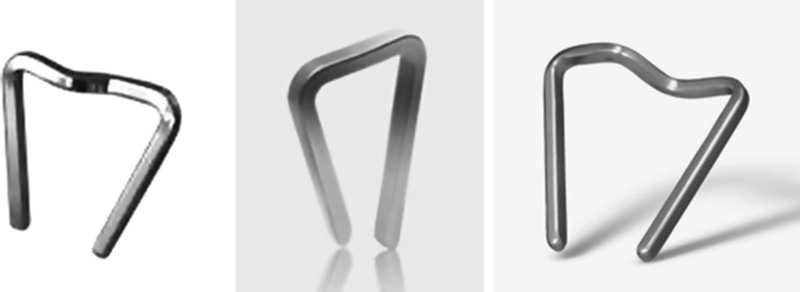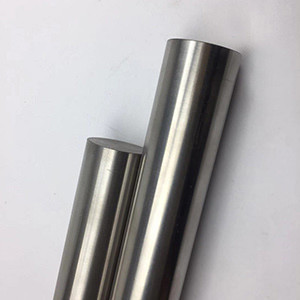Nitinol memory alloy is a shape memory alloy that changes with temperature. It has the advantages of abrasion resistance, corrosion resistance, fatigue resistance and elasticity. Based on this, the Nitinol memory alloy fixture can fix the special fracture parts of the human body such as the clavicle, acromioclavicular joint, olecranon, radius, femur, and patella, and the resulting restoring stress can continue to compress, stretch and open the fractured end. Anti-rotation, so as to achieve good fixation and accelerate the healing of the fracture.
Nitinol memory alloy embracing device
The Nitinol memory alloy embracing device is straight or arc-shaped and consists of 4 groups of ring arms. The ring arm is designed with a tooth-like structure to firmly fix the broken ends. It can be used for clavicle fractures, rib fractures, multiple rib fractures, and radius and ulna Fractures, etc.
For clavicle fractures, a Nitinol memory alloy clavicle embracing device with a diameter of 85% to 90% of the diameter of the clavicle is generally selected. When the middle part of the clavicle is broken, the straight embracing device can be used; when the outer 1/3 of the clavicle is broken, the arc embracing device can be used. After exposing the fractured end of the bone during the operation, immerse the NiTi memory alloy clavicle embracing device in ice-salt water below 4 ℃, and perform shaping after the hardness decreases. After the fracture end is reduced satisfactorily, open all the arms of the Nitinol memory alloy clavicle embracing device, spanning the fractured end, and place it in front of or behind the clavicle. When the temperature returns to 37 ℃, the Nitinol memory alloy clavicle embracing device is The shape and hardness will gradually recover, so that the 4 ring arms can be tightly occluded on both sides of the clavicle fracture, forming a solidly fixed Ni-Ti memory alloy rib embracing device, which can be used for rib fractures, especially for multiple rib fractures. When multiple rib fractures occur, the fractured ends will continue to irritate the pleura, increase the patient’s pain, inhibit breathing, and affect the circulatory system. Nitinol memory alloy rib embracing device belongs to Nitinol memory alloy serrated embracing device, which can quickly restore the thoracic structure, reduce the stimulation of the pleura, restore cough, sputum and other functions, and reduce postoperative complications such as lung infection. During the operation, there is no need to drill and nail, and the blood supply of the periosteum and medullary cavity can be preserved to the greatest extent, so as to facilitate rapid postoperative healing. The effect of the titanium memory alloy embracing device in the treatment of multiple rib fractures is better than the traditional conservative treatment.
Nitinol memory alloy nested interlocking intramedullary nail
Nitinol memory alloy sleeved interlocking intramedullary nails are often used for humeral fractures. They are composed of a main nail and a secondary nail. There are 2 locking nail holes at the proximal end. The main nail and the secondary nail extend into two wings, and the included angle is 35°~40° , In Y shape, and 2 interlocking nails. The Nitinol memory alloy nested interlocking intramedullary nail has the characteristics of less trauma, short operation time and elastic modulus to be close to the bone to reduce stress shielding and other characteristics, which is beneficial to accelerate the healing of bone fractures. The two-winged structure in the humeral medullary cavity will exert pressure on the inner wall, and has the effect of resisting rotation and lateral displacement. Soften the Nitinol memory alloy sleeved interlocking intramedullary nails in 0 ℃ ~ 4 ℃ ice and salt water. The main and auxiliary nails are bent from straight to straight and inserted into the medullary cavity to connect the fractured ends of the bone. When the temperature returns to 37 ℃, the Y-shaped two wings gradually spread apart, exerting pressure on the inner wall of the medullary cavity, and finally two locking nails are driven into the proximal end of the intramedullary nail with the aiming device. The comparative test showed that the Nitinol memory alloy nested interlocking intramedullary nail has no significant difference in bending resistance and torsion resistance with the steel plate, and it is better than the Ender nail.
Distal end of radius anatomical memory concentrator
The distal radius dissection type memory concentrator can be used to treat the fracture and nonunion of the distal radius. The concentrator is composed of three parts: the bone plate, the bone holder, and the longitudinal compression support. The bone-holding part embracing arm includes 8-12 bone-holding branches, which can produce multi-point fixation, and can disperse the pressure of the recovery stress on the bone, reduce the possibility of osteonecrosis, and the distal compression polymerization part has a centripetal polymerization effect , Suitable for comminuted fractures of the distal radius.
Ulna olecranon plate
Nitinol memory alloy olecranon bone plate can be used to treat olecranon C olton type Ⅱ fractures. The olecranon hook part can continuously pressurize the fractured olecranon through the inner and outer hooks. It has simple operation, small surgical damage and firm fixation. Etc .
Nitinol memory alloy wrist fusion device
Nitinol shape memory alloy quadrilateral fusion (NT-FCAC) is an internal fixation device suitable for Chinese quadrilateral fusion. Compared with Kirschner wire fixed quadrilateral fusion, it has greater fixation strength, and can be used for early functional exercise and complications after surgery. Few advantages. NT-FC AC is composed of a body and 4 fixed arms. Each arm has an angle of 70° with the body. It can be used for fusion of head bones, lunate bones, triangle bones and hook bones. After biomechanical testing, NT-FCAC can meet the requirements of no external fixation and early functional exercise after quadrangular fusion surgery, and fatigue can also meet the needs of bone healing.
The Nitinol memory alloy triangular fusion device (NT-STTA C) can be used to fuse the scaphoid, large and small polygonal bones to treat rotational subluxation of the scaphoid bone and aseptic necrosis of the lunar bone. Finite element analysis shows that NT-ST TC can meet the requirements of early and moderate exercise of wrist joint function after surgery.
Nitinol memory alloy patella concentrator
The Nitinol memory alloy patella concentrator (NT-PC) can be used for patella fractures. It consists of two base patellar claws and three apical patellar claws connected through the waist. NT-PC at 37 ℃ can produce a recovery force pointing to the center of the patella from 5 directions, and the patella bone fragments are continuously aggregated and compressed in the anatomical position. NT-PC is particularly effective in the treatment of crushed patella fractures. After the patella is fully exposed during the operation, debris and foreign bodies in the joint cavity are removed, the knee joint cavity is thoroughly washed, the patella fractured end is reset, the appropriate NT-PC is selected, and the 3 top patellar claws are pierced into the patella after low-temperature shaping The sharp ligament, after being heated and hardened, can produce the restoring force to grasp the patella. Studies have shown that NT-PC internal fixation of patella crushed bone fractures can improve the effect of postoperative knee joint rehabilitation, and has short operation time, simple operation, and early postoperative rehabilitation training, which is worthy of early rehabilitation.
Umbrella-shaped Nitinol Memory Alloy Femoral Head Support
Umbrella-shaped Nitinol memory alloy femoral head support is often used clinically for minimally invasive treatment of femoral head necrosis. It consists of an umbrella part and a tail part. The umbrella part is formed by the expansion of 8 umbrella arms, and the tail is formed by shrinking and gathering of 8 umbrella arms. Cylinder, and there are 8 outer hooks at the tail, which can hook the tube wall to prevent the bracket from slipping off. The umbrella-shaped Nitinol memory alloy support device is placed in the necrotic collapsed femoral head, and autologous bone or allogeneic bone bone grafting is performed, which can restore the shape and support of the necrotic femoral head.
NiTi memory alloy vertebral body support
Nitinol memory alloy vertebral body stents were implanted to treat thoracolumbar vertebral compression fractures after balloon expansion. A comparative study found that Nitinol memory alloy stents can expand and expand in the vertebral body to support and maintain the disease in the vertebral body. The role of vertebral reduction. From this, it can be seen that the Nitinol memory alloy vertebral support is a new exploration for the treatment of vertebral fractures without neurological symptoms.
NiTi memory alloy cervical spine clip hook
Nitinol memory alloy cervical spine clamp can be used to treat atlantoaxial instability. Its appearance is C-shaped. After softening in ice salt water, the upper and lower hooks are deployed. The upper hook is hooked on the upper edge of the posterior arch of the atlas, and the lower hook is hooked on the axis At the lower edge of the plate, when the temperature returns to 37 ℃, the C-shaped alloy cervical spine gripper produces a huge restoring force for continuous compression, so that the atlanto-axial spine is firmly fixed.
Spine Nitinol Memory Alloy Rod
The spine Nitinol memory alloy rod is widely used clinically to correct spinal deformities. Its sagittal plane is composed of multiple small arc-shaped rods connected smoothly. The coronal surface is linear. The upper part of the pedicle screw is designed with an opening for the placement of nickel. Titanium memory alloy rod [10]. During the operation, the segment to be corrected is inserted into the pedicle screw, and then the spine Nitinol memory alloy rod is immersed in ice-salt water for shaping, so that it fits the patient’s spinal curvature. Then place the spine Nitinol memory alloy rods in the opening grooves on both sides of the pedicle screws, and lock the caps. At this time, use 50 ℃ ~ 55 ℃ hot salt water to wet the spine Nitinol memory alloy rods. The continuous restoring force produced by the Nitinol memory alloy rod can be combined with manipulation to correct spinal deformity. When the restoring force is balanced with the deformity correction resistance, the autonomous orthopedic process is completed.
Advantages of NiTi memory alloy
Compared with traditional orthopedic internal fixation materials, Nitinol memory alloy has the following advantages:
- The elastic modulus is close to that of bone, and it is not easy to cause stress concentration and fractures around the prosthesis;
- After the fracture end is fixed, it will produce fretting, which is in line with the stress osteogenesis. Biomechanical properties of the human body;
- At normal body temperature, the Ni-Ti memory alloy will continue to pressurize the fracture end and accelerate the healing of the fracture;
- The fixation method is simple, the operation time is short, and the risk of infection is reduced;
- During the process of fixing the bone fracture, the damage to the periosteum is less, and to the greatest extent
- Protect the surrounding blood supply.
If you want to know more about Nitinol Memory Alloy, please feel free to contact us. Our technicians will be glad to help.


